Paper Menu >>
Journal Menu >>
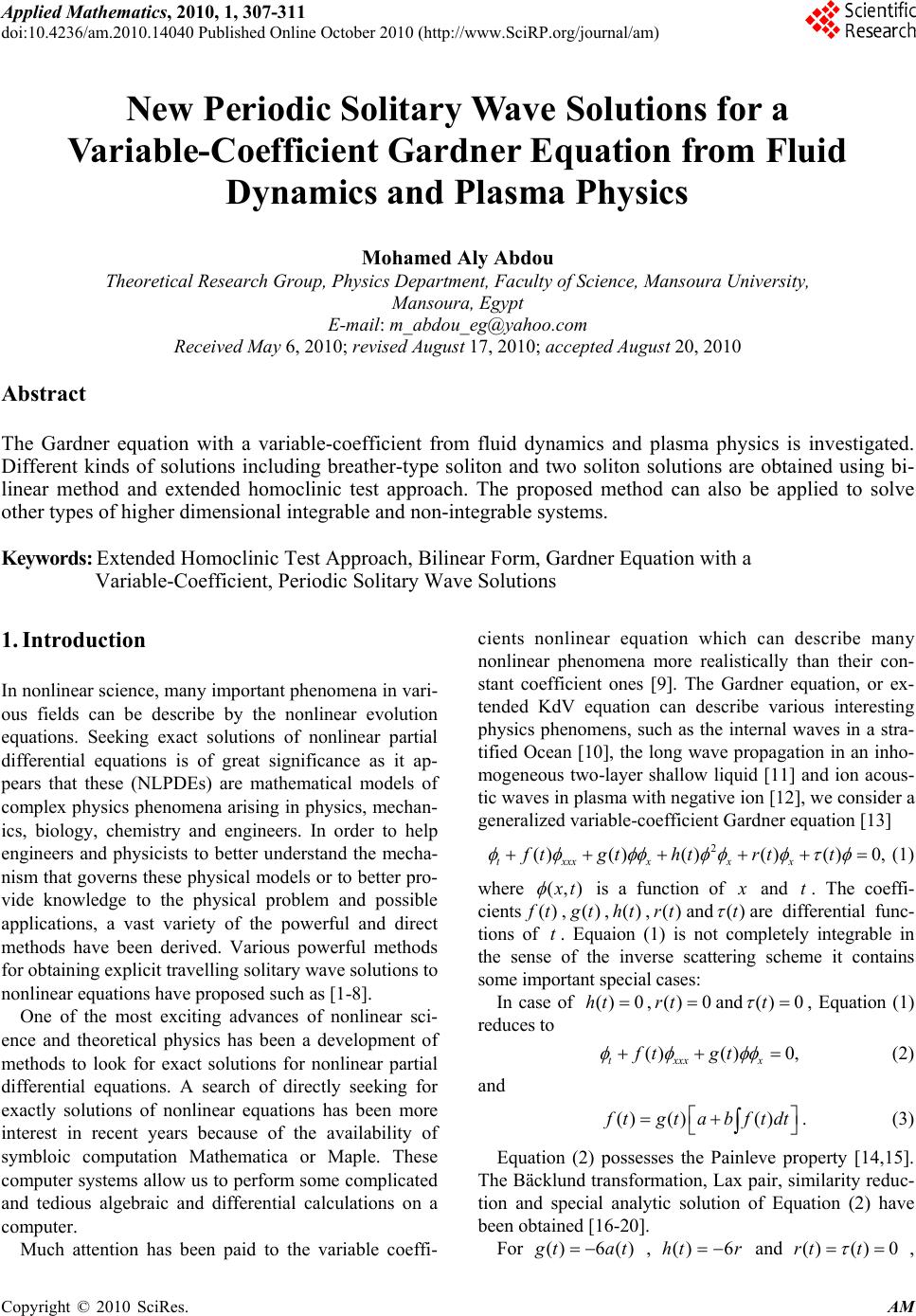 Applied Mathematics, 2010, 1, 307-311 doi:10.4236/am.2010.14040 Published Online October 2010 (http://www.SciRP.org/journal/am) Copyright © 2010 SciRes. AM New Periodic Solitary Wave Solutions for a Variable-Coefficient Gardner Equation from Fluid Dynamics and Plasma Physics Mohamed Aly Abdou Theoretical Re search Group, Physics Department, Faculty of Science, Mansoura University, Mansoura, Egypt E-mail: m_abdou_eg@yahoo.com Received May 6, 2010; revised August 17, 2010; accepted August 20, 2010 Abstract The Gardner equation with a variable-coefficient from fluid dynamics and plasma physics is investigated. Different kinds of solutions including breather-type soliton and two soliton solutions are obtained using bi- linear method and extended homoclinic test approach. The proposed method can also be applied to solve other types of higher dimensional integrable and non-integrable systems. Keywords: Extended Homoclinic Test Approach, Bilinear Form, Gardner Equation with a Variable-Coefficient, Periodic Solitary Wave Solutions 1. Introduction In nonlinear science, many important phenomena in vari- ous fields can be describe by the nonlinear evolution equations. Seeking exact solutions of nonlinear partial differential equations is of great significance as it ap- pears that these (NLPDEs) are mathematical models of complex physics phenomena arising in physics, mechan- ics, biology, chemistry and engineers. In order to help engineers and physicists to better understand the mecha- nism that governs these physical models or to better pro- vide knowledge to the physical problem and possible applications, a vast variety of the powerful and direct methods have been derived. Various powerful methods for obtaining explicit travelling solitary wave solutions to nonlinear equations have proposed such as [1-8]. One of the most exciting advances of nonlinear sci- ence and theoretical physics has been a development of methods to look for exact solutions for nonlinear partial differential equations. A search of directly seeking for exactly solutions of nonlinear equations has been more interest in recent years because of the availability of symbloic computation Mathematica or Maple. These computer systems allow us to perform some complicated and tedious algebraic and differential calculations on a computer. Much attention has been paid to the variable coeffi- cients nonlinear equation which can describe many nonlinear phenomena more realistically than their con- stant coefficient ones [9]. The Gardner equation, or ex- tended KdV equation can describe various interesting physics phenomens, such as the internal waves in a stra- tified Ocean [10], the long wave propagation in an inho- mogeneous two-layer shallow liquid [11] and ion acous- tic waves in plasma with negative ion [12], we consider a generalized variable-coefficient Gardner equation [13] 2 ()()()()() 0, txxx xxx ftgt htrtt (1) where (,) x t is a function of x and t. The coeffi- cients ()ft,() g t,()ht ,()rtand ()t are differential func- tions of t. Equaion (1) is not completely integrable in the sense of the inverse scattering scheme it contains some important special cases: In case of () 0ht ,() 0rt and ()0t , Equation (1) reduces to ()() 0, txxx x ft gt (2) and () ()()ftgta bftdt . (3) Equation (2) possesses the Painleve property [14,15]. The Bäcklund transformation, Lax pair, similarity reduc- tion and special analytic solution of Equation (2) have been obtained [16-20]. For ()6 () g tat ,() 6ht r and ()() 0rt t , 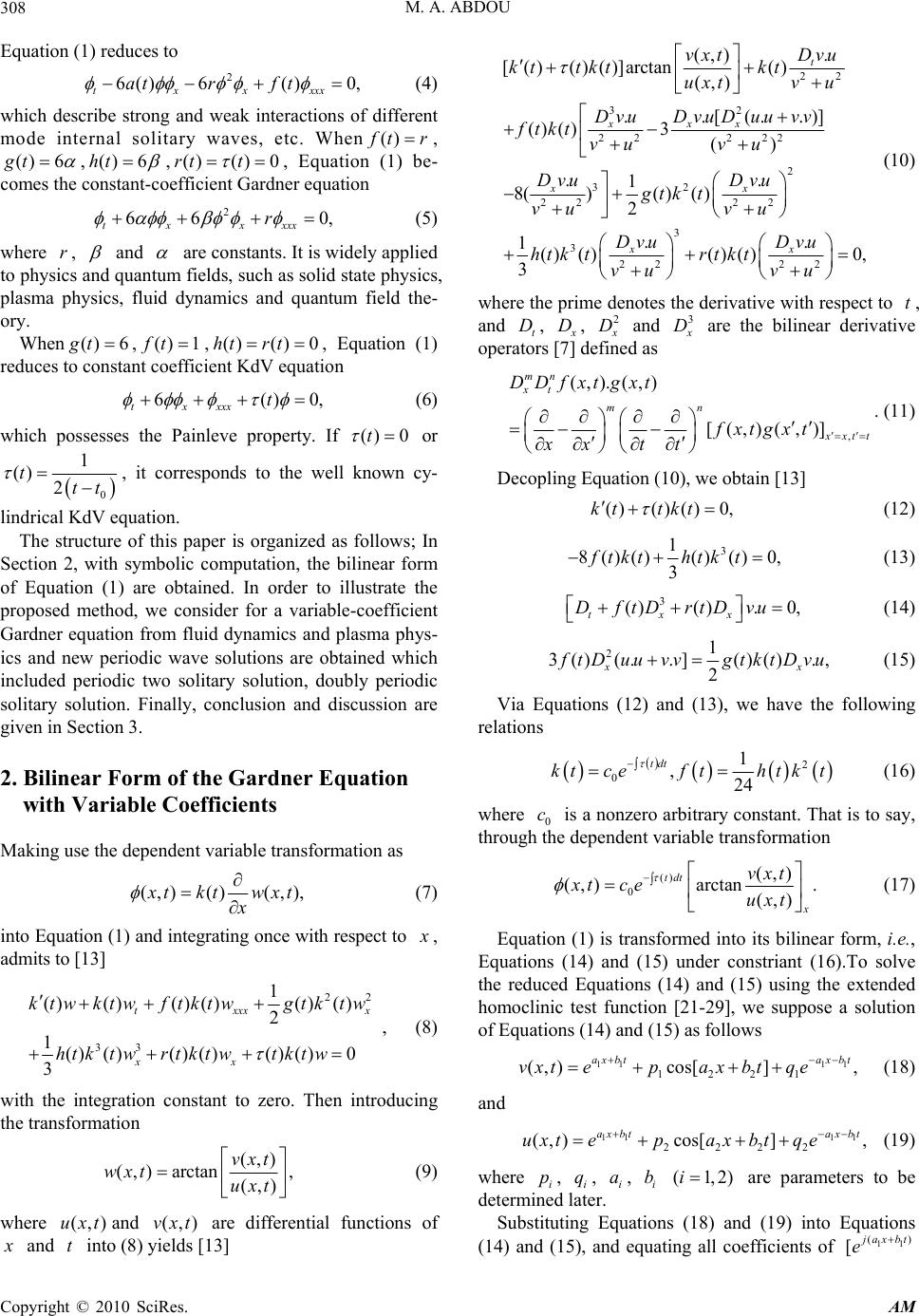 M. A. ABDOU Copyright © 2010 SciRes. AM 308 Equation (1) reduces to 2 6() 6()0, txxxxx atrf t (4) which describe strong and weak interactions of different mode internal solitary waves, etc. When() f tr , () 6gt ,() 6ht ,()() 0rt t , Equation (1) be- comes the constant-coefficient Gardner equation 2 66 0, tx xxxx r (5) where r, and are constants. It is widely applied to physics and quantum fields, such as solid state physics, plasma physics, fluid dynamics and quantum field the- ory. When ()6gt ,() 1ft,()()0htrt, Equation (1) reduces to constant coefficient KdV equation 6()0, tx xxxt (6) which possesses the Painleve property. If ()0t or 0 1 () 2 ttt , it corresponds to the well known cy- lindrical KdV equat i o n. The structure of this paper is organized as follows; In Section 2, with symbolic computation, the bilinear form of Equation (1) are obtained. In order to illustrate the proposed method, we consider for a variable-coefficient Gardner equation from fluid dynamics and plasma phys- ics and new periodic wave solutions are obtained which included periodic two solitary solution, doubly periodic solitary solution. Finally, conclusion and discussion are given in Section 3. 2. Bilinear Form of the Gardner Equation with Variable Coefficients Making use the dependent variable transformation as (,) ()(,), x tkt wxt x (7) into Equation (1) and integrating once with resp ect to x , admits to [13] 22 33 1 ()()() ()()() 2 1()()() ()() ()0 3 t xxxx xx ktwktwftktwgtk tw htk twrtktwtktw , (8) with the integration constant to zero. Then introducing the transformation (,) (,) arctan, (,) vxt wxt uxt (9) where (,)uxt and (,)vxt are differential functions of x and t into (8) yields [13] 22 32 22 222 2 32 22 22 3 3 22 2 . (,) [()( )( )]arctan( ) (,) ..[(..)] () ()3() .. 1 8()( )() 2 .. 1()()() () 3 t xxx xx xx Dvu vxt kt tktkt uxt vu DvuDvuD uuvv ftkt vu vu Dvu Dvu gtk t vu vu Dvu Dvu htk trtkt vu v 20, u (10) where the prime denotes the derivative with respect to t, and t D, x D, 2 x D and 3 x D are the bilinear derivative operators [7] d efined as , (,).(,) [(,)(,)] mn xt mn x xt t DDfxtgxt fxtgxt xx tt . (11) Decopling Eq u at i on (1 0) , we obt ai n [1 3] ()()()0,kt tkt (12) 3 1 8()()() ()0, 3 ftkthtk t (13) 3 ()(). 0, txx DftDrtDvu (14) 21 3() (..]()()., 2 xx f tD uuvvgtktDvu (15) Via Equations (12) and (13), we have the following relations 2 01 ,24 tdt ktcefthtk t (16) where 0 c is a nonzero arbitrary constant. That is to say, through the dependent variable transformation () 0(,) (,)arctan (,) tdt x vxt xt ceuxt . (17) Equation (1) is transformed into its bilinear form, i.e., Equations (14) and (15) under constriant (16).To solve the reduced Equations (14) and (15) using the extended homoclinic test function [21-29], we suppose a solution of Equations (14) and (15) as follows 11 11 1221 (,)cos[ ], ax btax bt vxtepax btqe (18) and 11 11 2222 (,)cos[ ], ax btax bt uxtepax btqe (19) where i p, i q, i a, i b (1,2)i are parameters to be determined later. Substituting Equations (18) and (19) into Equations (14) and (15), and equating all coefficients of 11 () [ j ax bt e 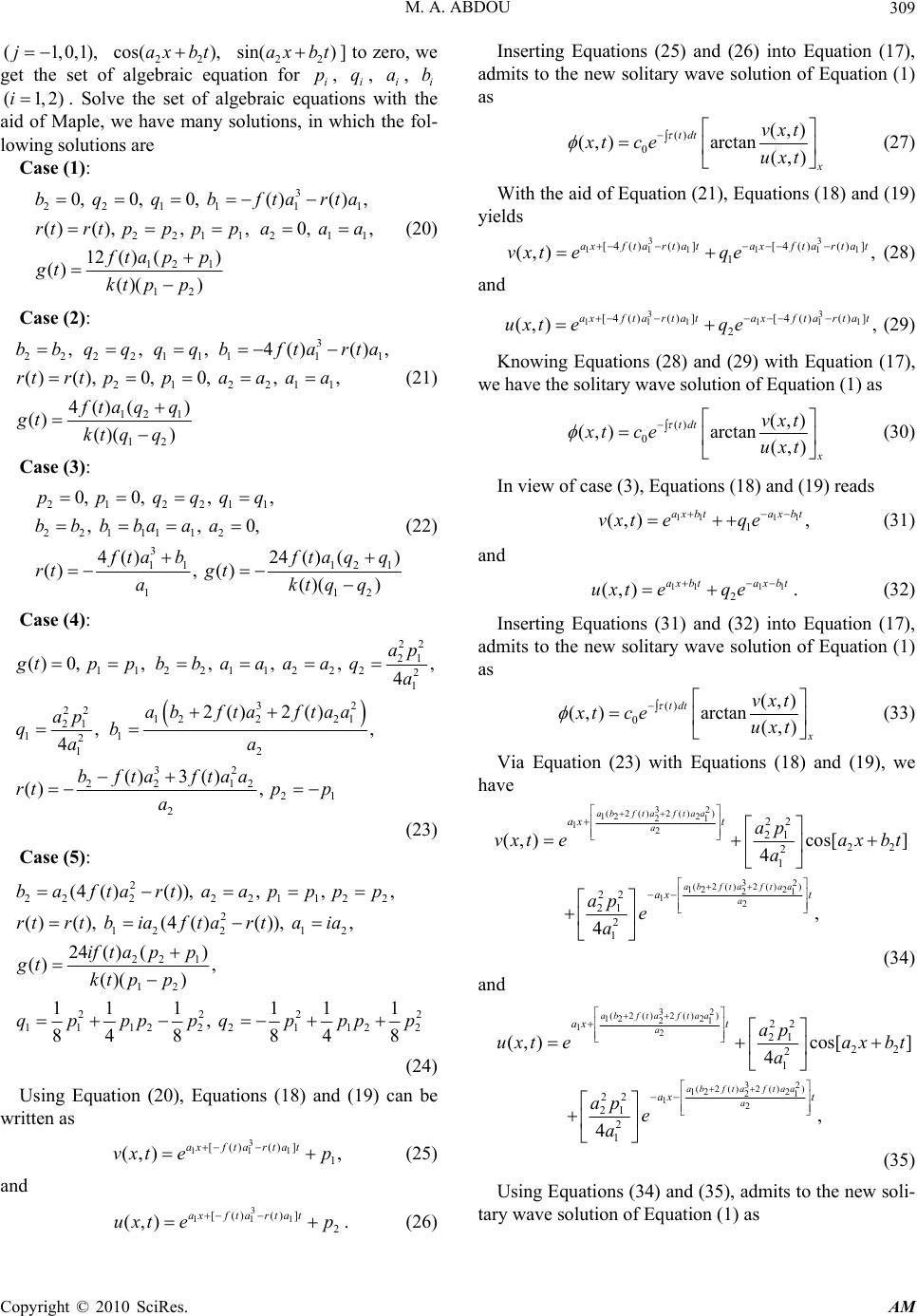 M. A. ABDOU Copyright © 2010 SciRes. AM 309 (1,0,1),j 22 cos( ),ax bt 22 sin( )ax bt] to zero, we get the set of algebraic equation for i p, i q, i a, i b (1,2)i. Solve the set of algebraic equations with the aid of Maple, we have many solutions, in which the fol- lowing solutions are Case (1): 3 221111 2211211 12 1 12 0, 0, 0, ()(), ()(), , , 0, , 12( )() () ()( ) bqqbftarta rtrt pp ppaaa fta pp gt kt pp (20) Case (2): 3 22221111 1 212211 12 1 12 , , , 4()(), ()(), 0, 0, , , 4()( ) () ()( ) bbqqqqbftarta rtrtppaa aa ftaq q gt kt qq (21) Case (3): 212211 2211112 3 11 121 112 0, 0, , , , , 0, 4()24()() (), ()()( ) ppqqqq bbbbaaa f tabftaqq rt gt aktqq (22) Case (4): 22 21 112211222 2 1 32 22 12 2 21 21 11 22 1 32 22 12 21 2 ()0, , , , , , 4 2() 2() , , 4 ()3 () (), ap gtppbbaa aaqa ab ftaftaa ap qb a a bfta ftaa rtp p a (23) Case (5): 2 22222112 2 2 12 212 22 1 12 2222 11 12221 122 (4()()), , , , ()(), (4()()), , 24( )() () , ()( ) 11 111 1 , 84 884 8 baftartaappp p rtrtbiaftartaia ift app gt kt pp qppppq pppp (24) Using Equation (20), Equations (18) and (19) can be written as 3 111 [() ()]1 (,) , axf tartat vxt ep (25) and 3 111 [()()]2 (,) axf tartat uxt ep . (26) Inserting Equations (25) and (26) into Equation (17), admits to the new solitary wave solution of Equation (1) as () 0(,) (,)arctan (,) tdt x vxt xt ceuxt (27) With the aid of Equation (21), Equations (18) and (19) yields 33 111 111 [ 4()()][ 4()()] 1 (,) , axftarta taxftarta t vxt eqe (28) and 33 111 111 [4()() ][4()() ] 2 (,) , axftarta taxftarta t uxt eqe (29) Knowing Equations (28) and (29) with Equation (17), we have the solitary wave solution of Equation (1) as () 0(,) (,)arctan (,) tdt x vxt xt ceuxt (30) In view of case (3), Equations (18) and (19) reads 11 11 1 (,) , ax btax bt vxt eqe (31) and 11 11 2 (,) ax btaxbt uxt eqe . (32) Inserting Equations (31) and (32) into Equation (17), admits to the new solitary wave solution of Equation (1) as () 0(,) (,)arctan (,) tdt x vxt xt ceuxt (33) Via Equation (23) with Equations (18) and (19), we have 32 (2()2() ) 12 2 21 12 32 (2()2() ) 12 2 21 12 22 21 22 2 1 22 21 2 1 (,)cos[ ] 4 , 4 ab ftaftaa a ab ftaftaa a ax t ax t ap vxteaxbt a ap e a (34) and 32 (2()2() ) 12 2 21 12 32 (2()2() ) 12 2 21 12 22 21 22 2 1 22 21 2 1 (,)cos[] 4 , 4 ab fta ftaa a ab ftaftaa a ax t ax t ap uxteaxbt a ap e a (35) Using Equations (34) and (35), admits to the new soli- tary wave solution of Equation (1) as 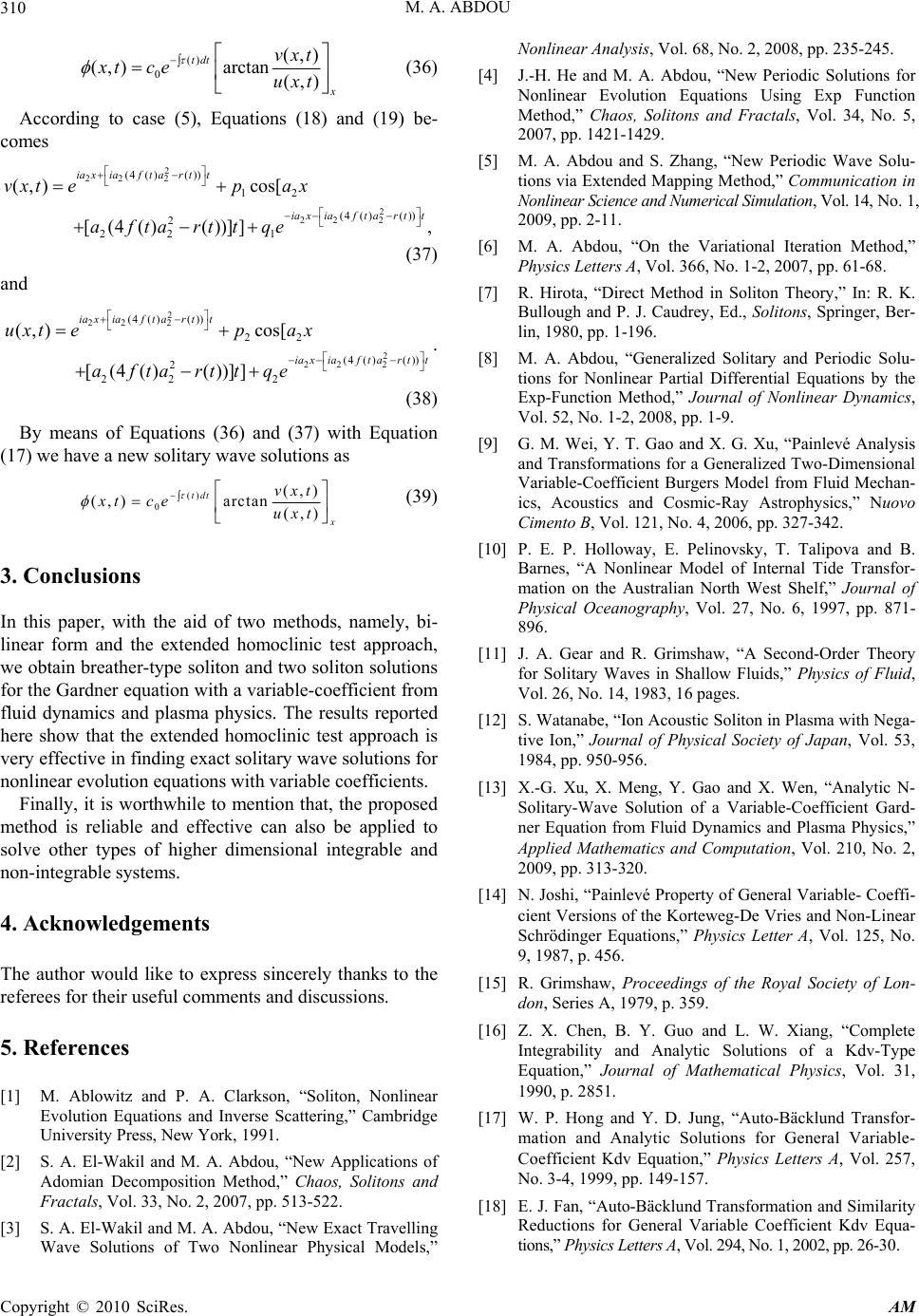 M. A. ABDOU Copyright © 2010 SciRes. AM 310 () 0(,) (,)arctan (,) tdt x vxt xt ceuxt (36) According to case (5), Equations (18) and (19) be- comes 2 22 2 2 22 2 (4 ()()) 12 (4 ()()) 2 22 1 (,) cos[ [(4()())]], ia xiaft ar tt ia xiaft ar tt vxt epax aftarttqe (37) and 2 22 2 2 22 2 (4 ()()) 22 (4 ()()) 2 22 2 (,) cos[ [(4()())]] ia xiaft ar tt ia xiaft ar tt uxt epax aftarttqe . (38) By means of Equations (36) and (37) with Equation (17) we have a new solitary wave solutions as () 0(,) (,)arctan (,) tdt x vxt xt ceuxt (39) 3. Conclusions In this paper, with the aid of two methods, namely, bi- linear form and the extended homoclinic test approach, we obtain breather-type soliton and two soliton solutions for the Gardner equation with a variable-coefficient from fluid dynamics and plasma physics. The results reported here show that the extended homoclinic test approach is very effective in finding exact solitary wave solutions for nonlinear evolution equations with variable coefficients. Finally, it is worthwhile to mention that, the proposed method is reliable and effective can also be applied to solve other types of higher dimensional integrable and non-integrable systems. 4. Acknowledgements The author would like to express sincerely thanks to the referees for their useful comments and discussions. 5. References [1] M. Ablowitz and P. A. Clarkson, “Soliton, Nonlinear Evolution Equations and Inverse Scattering,” Cambridge University Press, New York, 1991. [2] S. A. El-Wakil and M. A. Abdou, “New Applications of Adomian Decomposition Method,” Chaos, Solitons and Fractals, Vol. 33, No. 2, 2007, pp. 513-522. [3] S. A. El-Wakil and M. A. Abdou, “New Exact Travelling Wave Solutions of Two Nonlinear Physical Models,” Nonlinear Analysis, Vol. 68, No. 2, 2008, pp. 235-245. [4] J.-H. He and M. A. Abdou, “New Periodic Solutions for Nonlinear Evolution Equations Using Exp Function Method,” Chaos, Solitons and Fractals, Vol. 34, No. 5, 2007, pp. 1421-1429. [5] M. A. Abdou and S. Zhang, “New Periodic Wave Solu- tions via Extended Mapping Method,” Communication in Nonlinear Science and Numerical Simulation, Vol. 14, No. 1, 2009, pp. 2-11. [6] M. A. Abdou, “On the Variational Iteration Method,” Physics Letters A, Vol. 366, No. 1-2, 2007, pp. 61-68. [7] R. Hirota, “Direct Method in Soliton Theory,” In: R. K. Bullough and P. J. Caudrey, Ed., Solitons, Springer, Ber- lin, 1980, pp. 1-196. [8] M. A. Abdou, “Generalized Solitary and Periodic Solu- tions for Nonlinear Partial Differential Equations by the Exp-Function Method,” Journal of Nonlinear Dynamics, Vol. 52, No. 1-2, 2008, pp. 1-9. [9] G. M. Wei, Y. T. Gao and X. G. Xu, “Painlevé Analysis and Transformations for a Generalized Two-Dimensional Variable-Coefficient Burgers Model from Fluid Mechan- ics, Acoustics and Cosmic-Ray Astrophysics,” Nuovo Cimento B, Vol. 121, No. 4, 2006, pp. 327-342. [10] P. E. P. Holloway, E. Pelinovsky, T. Talipova and B. Barnes, “A Nonlinear Model of Internal Tide Transfor- mation on the Australian North West Shelf,” Journal of Physical Oceanography, Vol. 27, No. 6, 1997, pp. 871- 896. [11] J. A. Gear and R. Grimshaw, “A Second-Order Theory for Solitary Waves in Shallow Fluids,” Physics of Fluid, Vol. 26, No. 14, 1983, 16 pages. [12] S. Watanabe, “Ion Acoustic Soliton in Plasma with Nega- tive Ion,” Journal of Physical Society of Japan, Vol. 53, 1984, pp. 950-956. [13] X.-G. Xu, X. Meng, Y. Gao and X. Wen, “Analytic N- Solitary-Wave Solution of a Variable-Coefficient Gard- ner Equation from Fluid Dynamics and Plasma Phy sics,” Applied Mathematics and Computation, Vol. 210, No. 2, 2009, pp. 313-320. [14] N. Joshi, “Painlevé Property of General Variable- Coeffi- cient Versions of the Korteweg-De Vries and Non-Linear Schrödinger Equations,” Physics Letter A, Vol. 125, No. 9, 1987, p. 456. [15] R. Grimshaw, Proceedings of the Royal Society of Lon- don, Series A, 1979, p. 359. [16] Z. X. Chen, B. Y. Guo and L. W. Xiang, “Complete Integrability and Analytic Solutions of a Kdv-Type Equation,” Journal of Mathematical Physics, Vol. 31, 1990, p. 2851. [17] W. P. Hong and Y. D. Jung, “Auto-Bäcklund Transfor- mation and Analytic Solutions for General Variable- Coefficient Kdv Equation,” Physics Letters A, Vol. 257, No. 3-4, 1999, pp. 149-157. [18] E. J. Fan, “Auto-Bäcklund Transformation and Similarity Reductions for General Variable Coefficient Kdv Equa- tions,” Phys ics Le tters A, Vol. 294, No. 1, 2002, pp. 26-30. 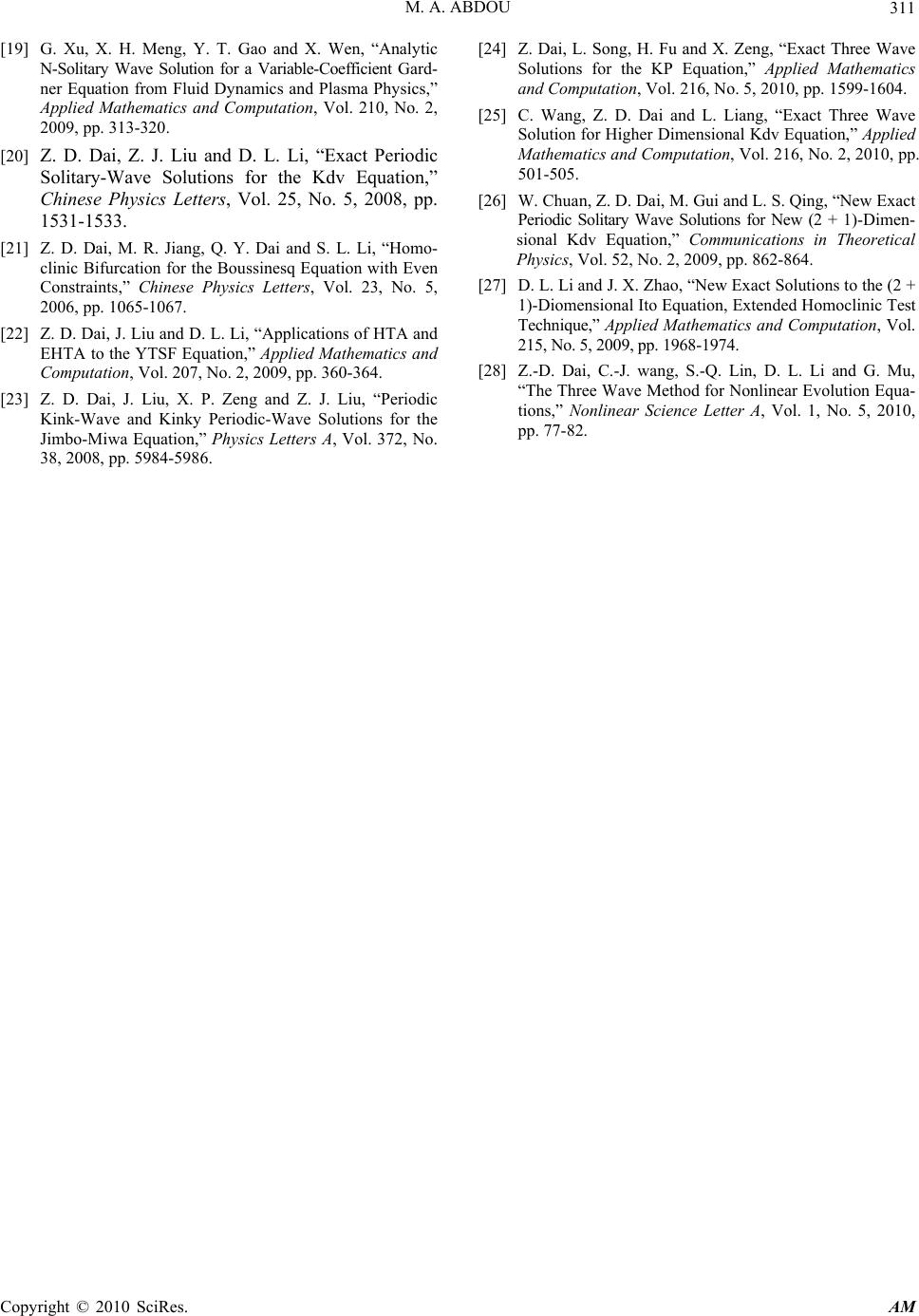 M. A. ABDOU Copyright © 2010 SciRes. AM 311 [19] G. Xu, X. H. Meng, Y. T. Gao and X. Wen, “Analytic N-Solitary Wave Solution for a Variable-Coefficient Gard- ner Equation from Fluid Dynamics and Plasma Phy sics,” Applied Mathematics and Computation, Vol. 210, No. 2, 2009, pp. 313-320. [20] Z. D. Dai, Z. J. Liu and D. L. Li, “Exact Periodic Solitary-Wave Solutions for the Kdv Equation,” Chinese Physics Letters, Vol. 25, No. 5, 2008, pp. 1531-1533. [21] Z. D. Dai, M. R. Jiang, Q. Y. Dai and S. L. Li, “Homo- clinic Bifurcation for the Boussinesq Equation with Even Constraints,” Chinese Physics Letters, Vol. 23, No. 5, 2006, pp. 1065-1067. [22] Z. D. Dai, J. Liu and D. L. Li, “Applications of HTA and EHTA to the YTSF Equation,” Applied Mathematics and Computation, Vol. 207, No. 2, 2009, pp. 360-364. [23] Z. D. Dai, J. Liu, X. P. Zeng and Z. J. Liu, “Periodic Kink-Wave and Kinky Periodic-Wave Solutions for the Jimbo-Miwa Equation,” Physics Letters A, Vol. 372, No. 38, 2008, pp. 5984-5986. [24] Z. Dai, L. Song, H. Fu and X. Zeng, “Exact Three Wave Solutions for the KP Equation,” Applied Mathematics and Computation, Vol. 216, No. 5, 2010, pp. 1599-1604. [25] C. Wang, Z. D. Dai and L. Liang, “Exact Three Wave Solution for Higher Dimensional Kdv Equation,” Applied Mathematics and Computation, Vol. 216, No. 2, 2010, pp. 501-505. [26] W. Chuan, Z. D. Dai, M. Gui and L. S. Qing, “New Exact Periodic Solitary Wave Solutions for New (2 + 1)-Dimen- sional Kdv Equation,” Communications in Theoretical Physics, Vol. 52, No. 2, 2009, pp. 862-864. [27] D. L. Li and J. X. Zhao, “New Exact Solutions to the (2 + 1)-Diomensional Ito Equation, Extended Homoclinic Test Technique,” Applied Mathematics and Computation, Vol. 215, No. 5, 2009, pp. 1968-1974. [28] Z.-D. Dai, C.-J. wang, S.-Q. Lin, D. L. Li and G. Mu, “The Three Wave Method for Nonlinear Evolution Equa- tions,” Nonlinear Science Letter A, Vol. 1, No. 5, 2010, pp. 77-82. |

